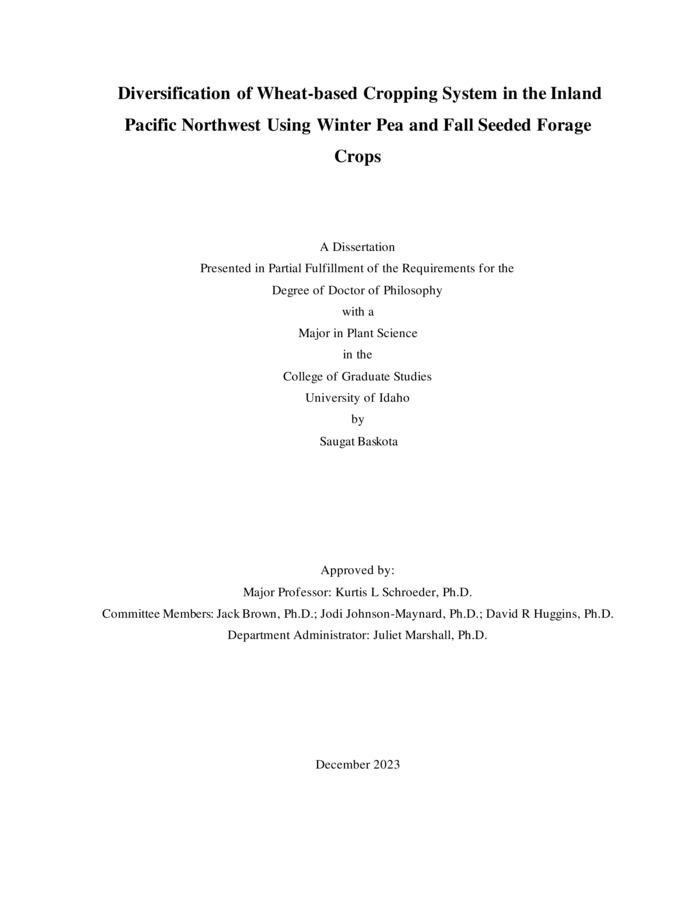Diversification of Wheat-based Cropping System in the Inland Pacific Northwest Using Winter Pea and Fall Seeded Forage Crops
Baskota, Saugat. (2023-12). Diversification of Wheat-based Cropping System in the Inland Pacific Northwest Using Winter Pea and Fall Seeded Forage Crops. Theses and Dissertations Collection, University of Idaho Library Digital Collections. https://www.lib.uidaho.edu/digital/etd/items/baskota_idaho_0089e_12692.html
- Title:
- Diversification of Wheat-based Cropping System in the Inland Pacific Northwest Using Winter Pea and Fall Seeded Forage Crops
- Author:
- Baskota, Saugat
- Date:
- 2023-12
- Keywords:
- Alternative crops Forage crops Winter pea
- Program:
- Plant Sciences
- Subject Category:
- Plant sciences; Agronomy
- Abstract:
-
The dryland production region of the Inland Pacific Northwest (IPNW) is dominated by wheat-based cropping systems. Unusually wet springs and early hot summer weather can negatively impact spring planted crops and these conditions are predicted to become more frequent and intense with climate change. A possible solution is to diversify the existing cropping system by incorporating additional fall seeded crops to cope with unique challenges in the different agroecological regions of the IPNW. Due to cold winters and lack of summer precipitation or access to irrigation, there are very few crop options that can be incorporated into the existing cropping system. Winter pea and forage crops were explored as options for crops that can be grown in the dryland IPNW. Three separate field studies were conducted at each Genesee, ID and St. John, WA during the 2017 to 2021 growing seasons. In the first study, winter pea and fall or spring seeded forage crops were incorporated in place of traditional spring crops or fallow depending on the location and were compared to the standard cropping system for both regions. Inclusion of alternative crops in the rotation at Genesee did not impact the yield of any subsequent crops in the rotations. At St. John, there was a 16 and 12% reduction in winter wheat yield when fallow was replaced with winter pea and spring forage mix, respectively. While the soil moisture content was comparable with that measured under similar crops at Genesee, there was significantly less moisture in the plots with winter pea or spring forage mix compared to fallow at St. John, which ultimately reduced the yield of winter wheat following these alternative crops. Economic analyses of incorporating winter pea and forage mix increased the total net returns of the 3-year rotation by 46 and 62% at Genesee and 66 and 77% at St. John, respectively, compared to the standard rotation at each location. There also was a significant reduction in the use of pesticides and fertilizers.To complement the rotation study, small scale plots were established to examine best management practices for winter pea production, as well as explore different winter forage crops mixes. The winter pea study included two commercial winter pea cultivars grown with three seeding dates, four seeding rates (65, 87, 108 and 130 seeds m-2), and with and without starter fertilizer. Early seeding of winter pea with a seeding rate of 107 to 130 seeds m-2 produced the highest yields at both locations. At Genesee, there was an average reduction of 210 kg ha-1 in yield for each week seeding was delayed between the end of September and late October/early November. Application of phosphorus and sulfur starter fertilizers did not have an impact on stand establishment or yield. In the forage mixture study, different mixtures of winter barley, winter oat, winter pea, crimson clover, balansa clover and radish were evaluated for establishment, forage yield and forage quality. The cultivars of barley, oat and pea utilized were all originally developed for forage production. Fall seeded forage crops evaluated at Genesee and St. John produced an average of 3,995 kg ha-1 and 2,832 kg ha-1 of dry matter, respectively, and had acceptable forage quality. The crimson clover, balansa clover and radish had very poor or no establishment at either location. In contrast, winter barley and winter pea had the best establishment in the mixtures at Genesee, while winter oat and winter pea were the prominent crops at St. John. The mixture of winter barley and winter pea producing 5,890 kg ha-1 at Genesee and the mixture of winter oat and winter pea producing 3,269 kg ha-1 at St. John had the highest dry matter production. Spring planted crops in the high precipitation region and fallow in the intermediate precipitation region of the IPNW were successfully replaced by winter peas and forage crops. The results from these studies highlight the benefits of using winter pea and forage crops in IPNW rotations as well as practices that can improve the productivity of both crops. Integration of these fall seeded options will help to develop a more resilient and sustainable cropping system for the intermediate and high precipitation region of the IPNW.
- Description:
- doctoral, Ph.D., Plant Sciences -- University of Idaho - College of Graduate Studies, 2023-12
- Major Professor:
- Schroeder, Kurtis L
- Committee:
- Johnson-Maynard, Jodi L; Brown, Jack; Huggins, David R; Marshall, Juliet
- Defense Date:
- 2023-12
- Identifier:
- Baskota_idaho_0089E_12692
- Type:
- Text
- Format Original:
- Format:
- application/pdf
- Rights:
- In Copyright - Educational Use Permitted. For more information, please contact University of Idaho Library Special Collections and Archives Department at libspec@uidaho.edu.
- Standardized Rights:
- http://rightsstatements.org/vocab/InC-EDU/1.0/

